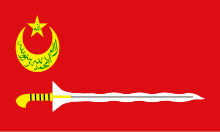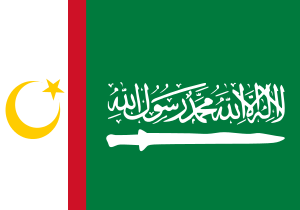Autonomous Region in Muslim Mindanao
| Autonomous Region in Muslim Mindanao | |||
|---|---|---|---|
| Region | |||
   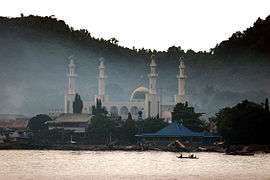 | |||
| |||
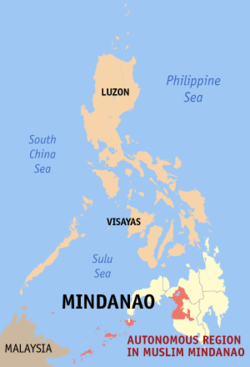 Location in the Philippines | |||
| Coordinates: 7°13′N 124°15′E / 7.22°N 124.25°ECoordinates: 7°13′N 124°15′E / 7.22°N 124.25°E | |||
| Country | Philippines | ||
| Island group | Mindanao | ||
| Regional center |
Cotabato City (provisional and de facto seat of government) Parang (de jure seat of government, 1995–2001)[1] | ||
| Government | |||
| • Governor | Mujiv S. Hataman (LP) | ||
| • Vice Governor | Haroun Lucman (LP) | ||
| Area[2] | |||
| • Total | 12,535.79 km2 (4,840.10 sq mi) | ||
| Population (2015 census)[3] | |||
| • Total | 3,781,387 | ||
| • Density | 300/km2 (780/sq mi) | ||
| Time zone | UTC+8 (PST) | ||
| ISO 3166 code | PH-14 | ||
| Provinces | |||
| Cities | |||
| Municipalities | 116 | ||
| Barangays | 2,490 | ||
| Cong. districts | 8 | ||
| Languages | |||
| Website |
www | ||
The Autonomous Region in Muslim Mindanao (Filipino: Awtonomong Rehiyon sa Muslim Mindanao,[4] Arabic: الحكم الذاتي لمسلمي مندناو Al-ḥukm adh-dhātiyy al-'aqlīmiyy limuslimiyy mindanāu;[5] abbreviated ARMM) is an autonomous region of the Philippines, located in the Mindanao island group of the Philippines, that consists of five predominantly Muslim provinces: Basilan (except Isabela City), Lanao del Sur, Maguindanao, Sulu, and Tawi-Tawi. It is the only region that has its own government. The region's de facto seat of government is Cotabato City, although this self-governing city is outside its jurisdiction.
The ARMM previously included the province of Shariff Kabunsuan until 16 July 2008, when Shariff Kabunsuan ceased to exist as a province after the Supreme Court of the Philippines declared the "Muslim Mindanao Autonomy Act 201", which created it, unconstitutional in Sema vs. COMELEC.[6]
On October 7, 2012, President Benigno Aquino III said that the government aimed to have peace in the autonomous region and that it will become known as the Bangsamoro Autonomous Region,[7] a compound of bangsa (nation) and Moro.[8] On July 26, 2018, Aquino's successor, President Rodrigo Duterte, signed the Bangsamoro Organic Law (BOL, formerly the Bangsamoro Basic Law or BBL), paving way for the abolition of ARMM, which will be succeeded by the Bangsamoro Autonomous Region.[9][10]
Geography
The Autonomous Region in Muslim Mindanao (ARMM) is situated in mainland Mindanao in the southern Philippines and was created by virtue of the Republic Act No. 6734 which signed into law by President Corazon Aquino on August 1, 1989. The plebiscite was conducted in the proposed area of ARMM on November 17, 1989 in the provinces of Maguindanao, Lanao del Sur, Sulu, and Tawi-Tawi.
The region was strengthened and expanded through the ratification of Republic Act No. 9054, amending for the purpose of Republic Act No. 6734, entitled "An Act Providing for the ARMM" as amended in September 2001. The plebiscite paved the way for the inclusion of the province of Basilan and the city of Marawi as part of ARMM.
History
For the most part of Philippines' history, the region and most of Mindanao have been a separate territory, which enabled it to develop its own culture and identity. The region has been the traditional homeland of Muslim Filipinos since the 15th century, even before the arrival of the Spanish, who began to colonize most of the Philippines in 1565. Muslim missionaries arrived in Tawi-Tawi in 1380 and started the colonization of the area and the conversion of the native population to Islam. In 1457, the Sultanate of Sulu was founded, and not long after that, the sultanates of Maguindanao and Buayan were also established. At the time when most of the Philippines was under Spanish rule, these sultanates maintained their independence and regularly challenged Spanish domination of the Philippines by conducting raids on Spanish coastal towns in the north and repulsing repeated Spanish incursions in their territory. It was not until the last quarter of the 19th century that the Sultanate of Sulu formally recognized Spanish suzerainty, but these areas remained loosely controlled by the Spanish as their sovereignty was limited to military stations and garrisons and pockets of civilian settlements in Zamboanga and Cotabato,[11] until they had to abandon the region as a consequence of their defeat in the Spanish–American War.
The Moros had a history of resistance against Spanish, American, and Japanese rule for over 400 years. The violent armed struggle against the Japanese, Filipinos, Spanish, and Americans is considered by current Moro Muslim leaders as part of the four centuries long "national liberation movement" of the Bangsamoro (Moro Nation).[12] The 400-year-long resistance against the Japanese, Americans, and Spanish by the Moro Muslims persisted and morphed into their current war for independence against the Philippine state.[13]
In 1942, during the early stages of the Pacific War of the Second World War, troops of the Japanese Imperial Forces invaded and overran Mindanao, and the native Moro Muslims waged an insurgency against the Japanese. Three years later, in 1945, combined United States and Philippine Commonwealth Army troops liberated Mindanao, and with the help of local guerrilla units, ultimately defeated the Japanese forces occupying the region.
Precursors
In the 1970s, escalating hostilities between government forces and the Moro National Liberation Front prompted President Ferdinand Marcos to issue a proclamation forming an Autonomous Region in the Southern Philippines. This was, however, turned down by a plebiscite. In 1979, Batas Pambansa No. 20 created a Regional Autonomous Government in the Western and Central Mindanao regions.[14]
Establishment of the ARMM
The Autonomous Region of Muslim Mindanao region was first created on August 1, 1989 through Republic Act No. 6734 (otherwise known as the Organic Act) in pursuance with a constitutional mandate to provide for an autonomous area in Muslim Mindanao.[15] A plebiscite was held in the provinces of Basilan, Cotabato, Davao del Sur, Lanao del Norte, Lanao del Sur, Maguindanao, Palawan, South Cotabato, Sultan Kudarat, Sulu, Tawi-Tawi, Zamboanga del Norte, and Zamboanga del Sur; and in the cities of Cotabato, Dapitan, Dipolog, General Santos, Koronadal, Iligan, Marawi, Pagadian, Puerto Princesa, and Zamboanga to determine if their residents wished to be part of the ARMM. Of these areas, only four provinces — Lanao del Sur (except Marawi City), Maguindanao, Sulu, and Tawi-Tawi — voted in favor of inclusion in the new autonomous region. The ARMM was officially inaugurated on November 6, 1990[16] in Cotabato City, which was designated as its provisional capital. Muslim Mindanao Autonomy Act No. 42, enacted on September 22, 1995, sought to permanently fix the seat of regional government at Parang in Maguindanao, pending the completion of required buildings and infrastructure.[1] However, the move to Parang was never made. Until the passage of Republic Act No. 9054 in 2001, which directed the ARMM Regional Government to once again fix a new permanent seat of government in an area within its jurisdiction,[17] Cotabato City remained the de facto seat of ARMM's government, and remains so at present.
2001 expansion of the ARMM
A new law, Republic Act No. 9054, was passed by Congress on February 7, 2001 with a view to expand the territory and powers of the ARMM by amending the original Organic Act (R.A. No. 6734) and calling for a plebiscite to ratify the amendments and confirm which other provinces and cities would like to join the region.[17] RA 9054 lapsed into law on March 31, 2001, without the signature of President Gloria Macapagal Arroyo.[17] A plebiscite was held on August 14 in the provinces of Basilan, Cotabato, Davao del Sur, Lanao del Norte, Lanao del Sur, Maguindanao, Palawan, Sarangani, South Cotabato, Sultan Kudarat, Sulu, Tawi-Tawi, Zamboanga del Norte, Zamboanga del Sur, and Zamboanga Sibugay, and the cities of Cotabato, Dapitan, Dipolog, General Santos, Iligan, Kidapawan, Marawi, Pagadian, Puerto Princesa, Digos, Koronadal, Tacurong, and Zamboanga. In the plebiscite, a majority of votes cast in the original four provinces were in favor of the amendments; outside these areas, only Marawi and the province of Basilan (excluding Isabela City) opted to be included in the ARMM.[17]
Creation and disestablishment of Shariff Kabunsuan
The ARMM's sixth province, Shariff Kabunsuan, was carved out of Maguindanao on October 28, 2006.[18] However, on July 16, 2008 the Supreme Court of the Philippines voided the creation of Shariff Kabunsuan, declaring unconstitutional Section 19 in RA 9054 which granted the ARMM Regional Assembly the power to create provinces and cities. The Supreme Court held that only Congress was empowered to create provinces and cities because the creation of such necessarily included the power to create legislative districts, which explicitly under the Philippine Constitution was within the sole prerogative of Congress to establish.[19]
Memorandum of Agreement on Ancestral Domain
On July 18, 2008, Hermogenes Esperon, peace advisor to then President Gloria Macapagal Arroyo, in his talks with Moro Islamic Liberation Front rebels in Malaysia, revealed the planned expansion of the region.[20] The deal, negotiated in secret talks with the MILF and subject to approval, would give the ARMM control of an additional 712 villages on the south west portion of Mindanao, as well as broader political and economic powers.[20]
Massive protests, however, greeted the move of the Philippine government and MILF panels in signing a Memorandum of Agreement on Ancestral Domain as a majority of the local government units where these barangays are connected have already opted not to join the ARMM in two instances, 1989 and 2001.
On August 4, 2008, after local officials from Cotabato asked the Supreme Court to block the signing of the agreement between the Philippine government and MILF, the Court issued a temporary restraining order against the signing of the Memorandum of Agreement on Ancestral Domain (MOA-AD) between the Philippine government and the MILF rebels in Malaysia.[21] Several lawmakers had filed petitions with the Supreme Court to stop the Philippine government from concluding the MOA-AD due to lack of transparency and for MILF's failure to cut ties with the al-Qaeda-linked terrorist network Jemaah Islamiyah, which aims to establish a pan-Islamic state in Southeast Asia using MILF camps in southwestern Mindanao as training grounds and staging points for attacks.[22]
On October 14, 2008, the Supreme Court of the Philippines, by a vote of 8–7, declared “contrary to law and the Constitution” the Ancestral Domain Aspect (MOA-AD) of the Tripoli Agreement on Peace of 2001 between the Philippine government and the MILF.[23][24] The 89-page decision, written by Associate Justice Conchita Carpio-Morales ruled: “In sum, the Presidential Adviser on the Peace Process committed grave abuse of discretion when he failed to carry out the pertinent consultation process, as mandated by EO No. 3, RA 7160, and RA 8371. The furtive process by which the MOA-AD was designed and crafted runs contrary to and in excess of the legal authority, and amounts to a whimsical, capricious, oppressive, arbitrary and despotic exercise thereof. It illustrates a gross evasion of positive duty and a virtual refusal to perform the duty enjoined.”[25][26][27]
Bangsamoro state
Due to the challenges in establishing the Bangsamoro entity in the previous administrations, then Mayor Rodrigo Duterte of Davao City announced his intent to establish a federal form of government which would replace the unitary form of government in his campaign speeches for the 2016 Philippine presidential election, which he subsequently won. In his plan, ARMM, along with the areas that voted to be included in ARMM in 2001, plus Isabela City and Cotabato City, will become part of a federal state. Aquilino Pimentel Jr., a Duterte ally and advocate for federalism, said in an interview that Isabela City, Basilan, Lamitan, Sulu, and Tawi-tawi may become a single federal state, while Lanao del Sur, Marawi, Cotabato City, and Maguindanao may become a single federal state as well because the Muslims of the Sulu archipelago have a different heritage from the Muslims in mainland Mindanao.
Bangsa Sug and Bangsa Moro
In 2018, a unification gathering of all the sultans of the Sulu archipelago and representatives from all ethnic communities in the Sulu archipelago commenced in Zamboanga City, declaring themselves as the Bangsa Sug peoples and separating them from the Bangsa Moro peoples of mainland central Mindanao. They cited the complete difference in cultures and customary ways of life as the primary reason for their separation from the Muslims of mainland central Mindanao. They also called the government to establish a separate Philippine state, called Bangsa Sug, from mainland Bangsa Moro or to incorporate the Sulu archipelago to whatever state is formed in the Zamboanga peninsula, if ever federalism in the Philippines is approved in the coming years.[28]
Demographics
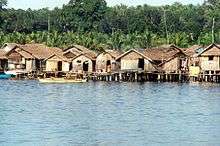
| Population census of ARMM | ||
|---|---|---|
| Year | Pop. | ±% p.a. |
| 1990 | 2,108,061 | — |
| 2000 | 2,803,045 | +2.89% |
| 2010 | 3,256,140 | +1.51% |
| 2015 | 3,781,387 | +2.89% |
| Source: Philippine Statistics Authority[3] [29] | ||
Administrative divisions
The Autonomous Region in Muslim Mindanao consists of 2 component cities, 116 municipalities, and 2,490 barangays. The cities of Isabela and Cotabato are not under the administrative jurisdiction of the ARMM.
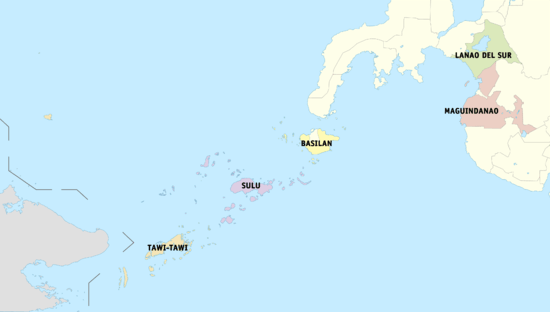
| Province | Capital | Population (2015)[3] | Area[2] | Density | Cities | Muni. | Bgy. | |||||
|---|---|---|---|---|---|---|---|---|---|---|---|---|
| km2 | sq mi | /km2 | /sq mi | |||||||||
| Basilan | Lamitan | 9.2% | 346,579 | 1,103.50 | 426.06 | 310 | 800 | 1 | 11 | 210 | ||
| Lanao del Sur | Marawi | 27.6% | 1,045,429 | 3,872.89 | 1,495.33 | 270 | 700 | 1 | 39 | 1,159 | ||
| Maguindanao[a] | Buluan | 31.0% | 1,173,933 | 4,871.60 | 1,880.94 | 240 | 620 | 0 | 36 | 508 | ||
| Sulu | Jolo | 21.8% | 824,731 | 1,600.40 | 617.92 | 520 | 1,300 | 0 | 19 | 410 | ||
| Tawi-Tawi | Bongao | 10.3% | 390,715 | 1,087.40 | 419.85 | 360 | 930 | 0 | 11 | 203 | ||
| Total | 3,781,387 | 12,535.79 | 4,836.23 | 300 | 780 | 2 | 116 | 2,490 | ||||
| ||||||||||||
Government
ARMM organizational structure
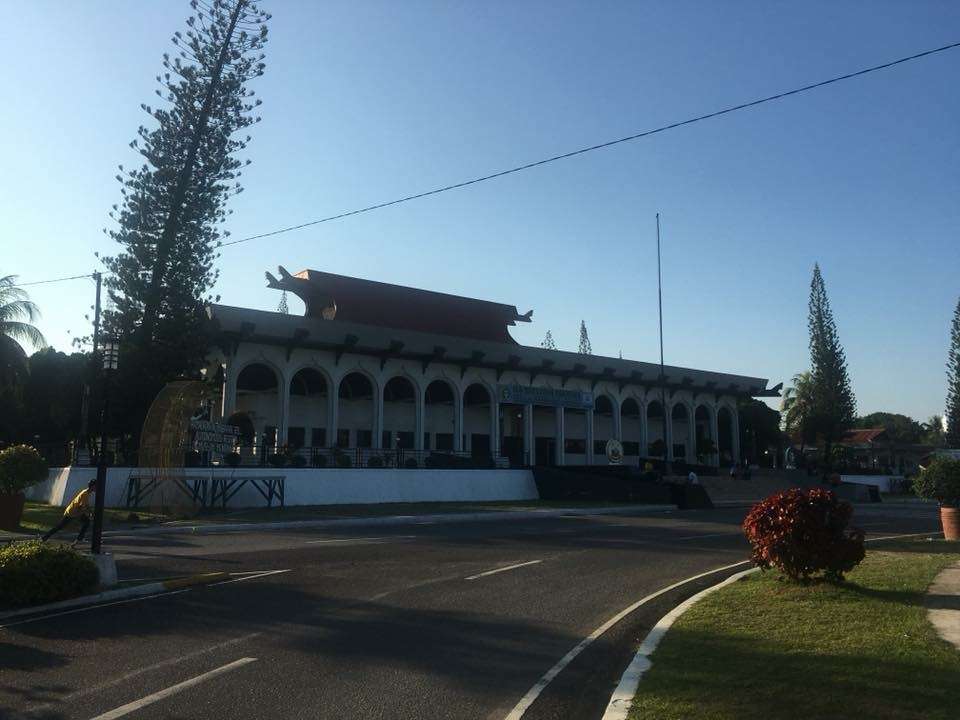
Executive
The region is headed by a Regional Governor. The Regional Governor and Regional Vice Governor are elected directly like regular local executives. Regional ordinances are created by the Regional Assembly, composed of Assemblymen, also elected by direct vote. Regional elections are usually held one year after general elections (national and local) depending on legislation from Congress. Regional officials have a fixed term of three years, which can be extended by an act of Congress.
The Regional Governor is the chief executive of the regional government, and is assisted by a cabinet not exceeding 10 members. He appoints the members of the cabinet, subject to confirmation by the Regional Legislative Assembly. He has control of all the regional executive commissions, agencies, boards, bureaus, and offices.
Executive council
The executive council advises the Regional Governor on matters of governance of the autonomous region. It is composed of the regional governor, 1 regional vice governor, and 3 deputy regional governors (each representing the Christians, the Muslims, and the indigenous cultural communities). The regional governor and regional vice governor have a 3-year term, maximum of 3 terms; deputies' terms are coterminous with the term of the regional governor who appointed them.
| Term | Governor | Party | Vice Governor | Party |
|---|---|---|---|---|
| 1990–1993 | Zacaria Candao | Lakas-NUCD | Benjamin Loong | Lakas-NUCD |
| 1993–1996 | Lininding Pangandaman | Lakas-NUCD-UMDP | Nabil Tan | Lakas-NUCD-UMDP |
| 1996–2001 | Nurallaj Misuari | Lakas-NUCD-UMDP | Guimid P. Matalam | Lakas-NUCD-UMDP |
| 2001 | Alvarez Isnaji[a] | Lakas-NUCD-UMDP | ||
| 2001–2005 | Parouk S. Hussin | Lakas-NUCD-UMDP | Mahid M. Mutilan | Lakas-NUCD-UMDP |
| 2005–2009 | Zaldy Ampatuan | Lakas Kampi CMD | Ansaruddin-Abdulmalik A. Adiong | Lakas Kampi CMD |
| 2009–2011 | Ansaruddin-Abdulmalik A. Adiong[a] | Lakas Kampi CMD | Reggie M. Sahali-Generale[a] | Lakas Kampi CMD |
| 2011–Present | Mujiv S. Hataman[b] | Liberal | Haroun Al-Rashid Lucman II[b] | Liberal |
Legislative
The ARMM has a unicameral Regional Legislative Assembly headed by a Speaker. It is composed of three members for every congressional district. The current membership is 24, where 6 are from Lanao del Sur including Marawi City, 6 from Maguindanao, 6 from Sulu, 3 from Basilan, and 3 from Tawi-Tawi.
The Regional Legislative Assembly is the legislative branch of the ARMM government. The regular members (3 members/district) and sectoral representatives, have three-year terms; maximum of three consecutive terms. It exercises legislative power in the autonomous region, except on the following matters: foreign affairs, national defense and security, postal service, coinage and fiscal and monetary policies, administration of justice, quarantine, customs and tariff, citizenship, naturalization, immigration and deportation, general auditing, national elections, maritime, land, and air transportation, communications, patents, trademarks, trade names, and copyrights, foreign trade, and may legislate on matters covered by the Sharia, the law governing Muslims.
ARMM powers and basic principles
RA 9054 provides that ARMM "shall remain an integral and inseparable part of the national territory of the Republic." The President exercises general supervision over the Regional Governor. The Regional Government has the power to create its own sources of revenues and to levy taxes, fees, and charges, subject to Constitutional provisions and the provisions of RA 9054. The Sharia applies only to Muslims; its applications are limited by pertinent constitutional provisions (prohibition against cruel and unusual punishment).[14]
Provincial Governors
ARMM voter registration
On June 16, 2012, the registration of 1,778,817 voters of the municipalities/cities in the ARMM was voided by a joint resolution of both Houses of Congress and approved by President Benigno Aquino III. The joint resolution mentioned the “presence of hundreds of thousands of illegal and fictitious registrants in the ARMM which needs to be deleted.”[31]
Economy
GRDP and GVA in Agriculture (2015)
| Item | At Current Prices | At Constant 2000 Prices |
|---|---|---|
| (in million pesos) | ||
| GRDP | 99,576 | 50,583 |
| GVA | 60,343 | 29,440 |
GRDP = Gross Regional Domestic Product
GVA = Gross Value Added in Agriculture, Hunting, Forestry and Fishing
In 2015, the region's economic performance decline by 0.4 percent. It contributed 0.7 percent to the country's Gross Domestic Product. Agriculture, Hunting, Forestry and Fishing sector had 1.5 percent contraction and it shared 58.2 percent in the regional economy.
GRDP Share by Industrial Origin:
Agriculture, Hunting, forestry and fishing - 58.2%
Service - 36.2%
Industry - 5.6%
Production
Production and Area (2015)
| Crop | Production (metric ton) | Area (hectare) |
|---|---|---|
| Palay | 488,215 | 194,349 |
| Corn | 673,036 | 282,295 |
source: countrystat.gov.ph[32]
The region's production of palay at 488,215 metric tons and corn at 673,036 metric tons contracted by 12.37 percent and 3.80 percent, respectively. Area harvested to palay decreased by 10.61 percent. Corn area expanded by 1.69 percent.
Agricultural output in ARMM declined by 1.77 percent in 2015. This was contributed by the production decreases in all subsectors except fisheries. The crops subsector which shared 69.79 percent in agricultural production posted 3.22 percent reduction. The fisheries subsector shared 24.30 percent. Its production grew by 2.57 percent.
Top Agricultural Commodities (2015)
| Commodity | Production Growth Rate | Share to Total Agricultural Output of the Region | Rank of the Region in the National Production |
|---|---|---|---|
| ---------- (in percent) ---------- | |||
| Cassava | (2.01) | 20.03 | 1st |
| Coconut | 2.73 | 13.71 | 4th |
| Corn | (3.8) | 12.77 | 4th |
| Palay | (12.37) | 12.34 | 11th |
| Seaweed | 0.71 | 6.02 | 1st |
Cassava, coconut, corn, palay and seaweed were the top five commodities produced in the region. These commodities contributed 64.87 percent to the region's agricultural output. ARMM ranked 1st in the production of cassava and seaweed.
Employment
Total Employment (CY2015) = 1,259,000 persons
Agricultural Employmen = 874,000 persons
By Sex:
Male = 676,000 persons
Female = 198,000 persons
Daily Agricultural Wage Rate by Sex (2015)
| Sex | Nominal | Real |
|---|---|---|
| (in pesos) | ||
| Male | 253.88 | 162.33 |
| Female | 161.04 | 102.97 |
| Both | 252.70 | 161.57 |
Employed persons in the agriculture sector comprised 69.4 percent of the region's total employment. Majority of the agricultural workers at 77.35 percent were males.
Cultural heritage
The people of the Bangsamoro region, including Muslims and non-Muslims, have a culture that revolves around kulintang music, a specific type of gong music, found among both Muslim and non-Muslim groups of the Southern Philippines. Each ethnic group in ARMM also has their own distinct architectures, intangible heritage, and craft arts. A fine example of a distinct architectural style in the region is the Royal Sulu architecture which was used to make the Daru Jambangan (Palace of Flowers) in Maimbung, Sulu. The palace was destroyed during the American period due to a typhoon in 1932, and was never rebuilt. It used to be the largest royal palace built in the Philippines. A campaign to faithfully re-establish it in Maimbung town has been ongoing since 1933. A very small replica of the palace was made in a nearby town in the 2010s, but it was noted that the replica does not mean that the campaign to reconstruct the palace in Maimbung has stopped as the replica does not manifest the true essence of a Sulu royal palace. In 2013, Maimbung was officially designated as the royal capital of the Sultanate of Sulu by the remaining members of the Sulu royal family.[33][34][35][36]
 Marawi, Lanao del Sur
Marawi, Lanao del Sur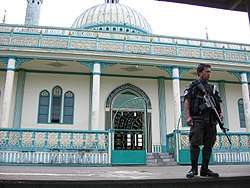
 Grand mosque of Cotabato City
Grand mosque of Cotabato City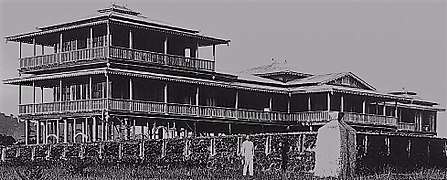

_Hospital_Ship_USNS_Mercy_(T-AH_19)_is_anchored_off_of_the_coast_of_Tawi_Tawi.jpg)
 Pagoda-style mosque in Taraka, Lanao del Sur
Pagoda-style mosque in Taraka, Lanao del Sur
Comparisons
| Body | (Central Government only) | ||
|---|---|---|---|
| Constitutional Document | ARMM Organic Act (Republic Act No. 6734) | Constitution of the Philippines | |
| Head of State / Territory | Regional Governor of the ARMM | President of the Philippines | |
| Head of Government | |||
| Executive | Executive Departments of the ARMM | Executive Departments of the Philippines | |
| Legislative | Unicameral: Regional Legislative Assembly | Bicameral: Senate and Congress | |
| Judiciary | None (under Philippine government) | Supreme Court | |
| Legal Supervisory or Prosecution |
None (under Philippine government) | Department of Justice | |
| Police Force(s) | None (under Philippine government) | Philippine National Police | |
| Military | None (under Philippine government) | Armed Forces of the Philippines (AFP) | |
| Currency | Philippine peso | Philippine peso | |
| Language(s) | Official: English, Filipino Auxiliary: Arabic, Tausug, Maranao, Zamboangueño, Yakan, Sama, Badjao, Maguindanaoan, Iranun, Manobo, Bagobo, Tiruray, T'boli |
Official: Filipino, English Auxiliary: Spanish, Arabic | |
| Foreign relations | None (under Philippine government) | full rights | |
| Shariah law application | Yes, for Muslims only[37] | Yes, for Muslims only[37] | |
See also
References
- 1 2 Regional Legislative Assembly of the Autonomous Region in Muslim Mindanao (September 22, 1995). "An Act Fixing the Permanent Seat of Government for the Autonomous Region in Muslim Mindanao at the Municipality of Parang, Province of Maguindanao" (PDF). Retrieved August 9, 2016.
- 1 2 "Bangsamoro Development Plan Integrative Report, Chapter 10" (PDF). Bangsamoro Development Agency. 2015. Retrieved 2016-05-31. See also talk page.
- 1 2 3 Census of Population (2015). Highlights of the Philippine Population 2015 Census of Population. PSA. Retrieved 20 June 2016.
- ↑ Panukalang Batas Blg. 4494.
- ↑ "Official Issuances". Autonomous Region in Muslim Mindanao. Retrieved 2016-04-16.
- ↑ Llanto, Jesus F. (17 July 2008). "Supreme Court voids creation of Shariff Kabunsuan". ABS-CBN News.
- ↑ "Govt reaches deal with MILF to end rebellion". ABS-CBN News. Retrieved 7 February 2015.
- ↑ "The Bangsamoro reframes the Muslim-Filipino identity". Retrieved 13 April 2015.
- ↑ News, ABS-CBN. "Duterte signs Bangsamoro law". ABS-CBN News. Retrieved 2018-07-26.
- ↑ "Duterte signs Bangsamoro Organic Law". cnn. Retrieved 2018-07-26.
- ↑ Mindanao Peace Process, Fr. Eliseo R. Mercado, Jr., OMI.
- ↑ Banlaoi 2012, p. 24.
- ↑ Banlaoi 2005 Archived 2016-02-10 at the Wayback Machine., p. 68.
- 1 2 "ARMM history and organization". GMA News Online. Retrieved 7 February 2015.
- ↑ "Republic Act No. 6734". Official Gazette. Republic of the Philippines. August 1, 1989.
- ↑ "Autonomous Region in Muslim Mindanao". United Nations. Archived from the original on 2013-10-15. Retrieved 2013-10-12.
- 1 2 3 4 Congress of the Philippines (March 31, 2001). "Republic Act No. 9054 - An Act to Strengthen and Expand the Organic Act for the Autonomous Region in Muslim Mindanao, Amending for the Purpose Republic Act No. 6734, entitled "An Act Providing for the Autonomous Region in Muslim Mindanao," as Amended" (PDF). Archived from the original (PDF) on 17 April 2016. Retrieved 9 August 2016.
- ↑ "Did you know that… ARMM now has Six Provinces". Philippine Statistics Authority. March 26, 2007. Archived from the original on July 4, 2008. Retrieved August 9, 2016.
- ↑ Llanto, Jesus F. (16 July 2008). "Supreme Court voids creation of Shariff Kabunsuan". ABS-CBN News. Archived from the original on 27 January 2016. Retrieved 27 January 2016.
- 1 2 "Philippines Muslim area to expand". BBC News. July 17, 2008. Retrieved April 26, 2010.
- ↑ "Errorpage - ABS-CBN News". Retrieved 7 February 2015.
- ↑ SENATORS: GOVT FAILED TO CUT TIES OF MILF W/ TERROR NETWORK JI Archived June 7, 2011, at the Wayback Machine. (August 26, 2008)
- ↑ Agreement on peace between the government of the Republic of the Philippines and the Moro Islamic Liberation Front, June 22, 2001.
- ↑ MoA with MILF unconstitutional - SC, Manila Bulletin, October 15, 2008.
- ↑ SC Declares MOA-AD Unconstitutional, Manila Bulletin, October 15, 2008.
- ↑ abs-cbnnews, Palace loses ancestral domain case with 8-7 SC vote
- ↑ "SC: MILF deal unconstitutional - INQUIRER.net, Philippine News for Filipinos". Archived from the original on 7 February 2015. Retrieved 7 February 2015.
- ↑ http://www.sunstar.com.ph/article/1742513/Zamboanga/Local-News/Sulu-Sultanate-Bangsa-Sug-push-revision-of-Bangsamoro-Basic-Law
- ↑ "Population and Annual Growth Rates for The Philippines and Its Regions, Provinces, and Highly Urbanized Cities" (PDF). 2010 Census and Housing Population. Philippine Statistics Authority. Archived from the original (PDF) on 28 September 2013. Retrieved 12 August 2013.
- ↑ Office of the Bangsamoro People inaugurated | The Manila Times
- ↑ Aquino, Leslie Anne G. (17 June 2012). "ARMM Voters' List Now Void". mb.com.ph. Retrieved 17 June 2012.
- ↑ Authority, Philippine Statistics. "Regional Profile: Autonomous Region in Muslim Mindanao (ARMM)". countrystat.psa.gov.ph. Retrieved 2017-12-01.
- ↑ http://newsinfo.inquirer.net/510823/before-his-death-kiram-iii-tells-family-to-continue-fight-to-re-possess-sabah
- ↑ http://www.manilatimes.net/sulu-sultan-dies-from-kidney-failure/219719/
- ↑ https://www.nytimes.com/2015/09/22/world/asia/esmail-kiram-ii-self-proclaimed-sultan-of-sulu-dies-at-75.html
- ↑ https://www.rappler.com/nation/41779-sulu-sultan-jamalul-kiram-iii-dies
- 1 2 Marcos, Ferdinand E. (4 February 1977). "Presidential Decree No. 1083 - A DECREE TO ORDAIN AND PROMULGATE A CODE RECOGNIZING THE SYSTEM OF FILIPINO MUSLIM LAWS, CODIFYING MUSLIM PERSONAL LAWS, AND PROVIDING FOR ITS ADMINISTRATION AND FOR OTHER PURPOSES". The LawPhil Project. Retrieved 18 November 2017.
External links
| Wikivoyage has a travel guide for Autonomous Region in Muslim Mindanao. |
| Wikimedia Commons has media related to Autonomous Region in Muslim Mindanao. |
.png)



